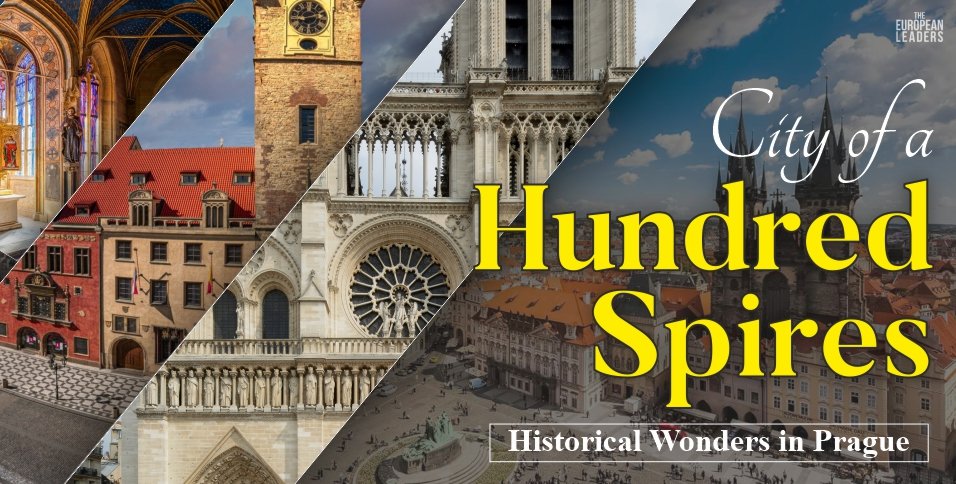Have you ever wondered why Prague is often called the city of a hundred spires? What makes its skyline so mesmerizing? This blog takes you on an immersive journey through Prague’s architectural marvels and cultural treasures, revealing why it remains one of Europe’s most enchanting cities.
Beyond that, you’ll explore the origins and evolution of Prague’s iconic spires. Each tells its own story of Gothic, Baroque, and Renaissance influences. In addition, you’ll discover the must-visit landmarks that define the city’s skyline. Consequently, this guide will provide a comprehensive view of why it is a must-see destination.
By the end of this blog, you’ll have a detailed understanding of Prague’s historical significance, the best accommodations, culinary delights, and essential tips for making the most of your visit. So, let’s begin!
The Origins and Evolution of the City of a Hundred Spires
The city of a hundred spires, a nickname for Prague, has its origins in the medieval era. Initially, the city’s stunning skyline was dominated by numerous Gothic churches and cathedrals, each adorned with towering spires. These architectural marvels were symbols of the city’s growing importance in Europe.
Over the centuries, Prague’s skyline continued to evolve, incorporating Baroque, Renaissance, and modern styles. Despite wars and political changes, the city’s commitment to preserving its architectural heritage remained steadfast. Each period left its mark, adding varied historical significance and visual splendor to the cityscape.
Today, Prague stands as evidence of its rich history, with its spires serving as enduring symbols of its cultural and architectural legacy. The city of a hundred spires continues to captivate visitors, offering a unique glimpse into the past while embracing the present.
Architectural Marvels: City of a Hundred Spires
Prague is renowned for its iconic spires, each with unique features. The spires of St. Vitus Cathedral stand tall, showcasing Gothic architecture’s intricate designs. Additionally, the Old Town Hall’s astronomical clock features a blend of medieval and Renaissance elements Consequently, captivating visitors with its detailed craftsmanship.
Furthermore by transitioning through the city, one can observe a variety of architectural styles. Baroque influences are evident in the Church of St. Nicholas, with its ornate decorations and dynamic shapes. Meanwhile, the spires of Týn Church reflect the grandeur of Gothic architecture, characterized by their soaring heights and pointed arches.
In addition, these diverse styles highlight Prague’s architectural evolution and its cultural richness. The blend of Gothic, Baroque, and Renaissance elements creates a visually stunning cityscape. Indeed, the city’s architectural marvels of a hundred spires offer a fascinating journey through time and art.
Cultural Significance of the City of a Hundred Spires
The city of a hundred spires profoundly influences local culture and traditions. Its rich architectural heritage inspires a deep sense of pride among residents, who celebrate their city’s history through various cultural practices. Moreover, the spires themselves often feature in local folklore and storytelling, highlighting their integral role in Prague’s identity.
Throughout the year, Prague hosts numerous festivals and events celebrating its unique heritage. The Prague Spring International Music Festival is one such event, attracting global artists and showcasing the city’s musical legacy. Additionally, the Prague Castle hosts the annual St. Vitus Cathedral Day, featuring concerts and exhibitions that emphasize the cultural importance of this iconic spire.
Beyond that, these festivals celebrate Prague’s architectural splendor and strengthen community bonds. They also provide a platform for locals and visitors alike to engage with the city’s rich history. Ultimately, the cultural significance of the city of a hundred spires is vividly reflected in its vibrant traditions and celebrations.
Accommodation in the City of a Hundred Spires
| Hotel Name | Description | Price Range (per night) |
| Hotel U Prince | Located in the Old Town Square, this historic hotel offers luxurious rooms with stunning views of the Astronomical Clock and nearby spires. | $200 – $350 |
| Four Seasons Hotel Prague | This five-star hotel combines modern comfort with historic charm, offering views of Prague Castle and Charles Bridge. | $400 – $700 |
| Golden Well Hotel | Nestled below Prague Castle, this boutique hotel provides a tranquil escape with panoramic views of the city’s spires. | $250 – $500 |
| Hotel Pod Věží | Situated by the Charles Bridge, this charming hotel offers cozy rooms and a rooftop terrace with beautiful city views. | $150 – $300 |
| Mosaic House Design Hotel | A stylish eco-friendly hotel near the city center, featuring modern amenities and unique design elements. | $100 – $250 |
| Aria Hotel Prague | A luxury hotel dedicated to music lovers, located in the Lesser Town, with a rooftop garden offering views of the city’s spires. | $300 – $600 |
| Hotel Paris Prague | A neo-Gothic gem with Art Nouveau interiors, located near the Powder Tower, offering a blend of historic elegance and modern comfort. | $180 – $400 |
| Hotel Josephine Old Town | A budget-friendly option in the heart of Old Town, providing comfortable rooms and easy access to major landmarks. | $80 – $150 |
Must-Visit Sites of the City of a Hundred Spires
When exploring Prague, certain landmarks stand out as must-visit sites. The Charles Bridge, with its statues and historic charm, offers stunning views of the city’s spires. Equally impressive is the Powder Tower, a Gothic structure that once formed part of Prague’s fortifications, providing a glimpse into the city’s medieval past.
Beyond the famous landmarks, Prague is home to hidden gems and lesser-known spires. For instance, the Church of St. James the Greater, tucked away in the Old Town, boasts a magnificent Baroque interior and a unique mummified arm hanging inside. Another gem is the Loreta, a baroque pilgrimage site with a charming bell tower that often goes unnoticed by tourists.
Consequently, these lesser-known sites add depth to the exploration of Prague. They further reveal the city’s layers of history and offer a more intimate experience. Discovering both renowned and hidden spires truly enriches any visit to the city of a hundred spires.
Five Fascinating Lesser-Known Facts of Prague
- Astronomical Clock Mystique: Prague’s Astronomical Clock, installed in 1410, is the third oldest astronomical clock in the world and the only one still operating. Legends say that the city would face disaster if the clock were to stop.
- Secret Tunnels: Beneath Prague’s streets lie a network of hidden tunnels and passageways, some dating back to the medieval era. These tunnels were used for various purposes, including escape routes and storage.
- Unique Bridge Statues: The Charles Bridge is adorned with 30 statues; interestingly, none are original. The originals were removed to protect them from weather damage, and replicas now stand in their place.
- Underground Beer Cellars: Prague’s historic cellars, used for brewing and storing beer, are among the oldest in Europe. Some breweries have cellars dating back to the 15th century, still in use today.
- Hidden Gardens: Tucked away in the Lesser Town, you can find several hidden gardens such as the Vrtba Garden. This Baroque garden, with its terraces and ornate design, offers a serene escape from the bustling city.
Prague’s Culinary Delights in the City of a Hundred Spires
In the city of a hundred spires, traditional Czech cuisine offers a delectable experience. Classic dishes like goulash served with hearty bread dumplings, and roast pork with sauerkraut are staples of local fare. Additionally, don’t miss out on trying “trdelník,” a sweet pastry often enjoyed with a dusting of sugar and cinnamon.
Moreover, Prague’s breweries and beer gardens are renowned for their unique charm and quality. Pilsner Urquell and other local brews can be enjoyed at historic establishments such as U Fleků, which also features traditional Czech fare. Beer gardens like Letná Beer Garden offer a relaxed atmosphere and stunning views of the city, perfect for savoring a pint of Czech beer.
Furthermore, food tours and culinary experiences provide an immersive way to explore Prague’s gastronomy. Guided tours often include tastings of local specialties and visits to hidden gems, enhancing your understanding of the city’s vibrant food scene. These experiences make exploring the city of a hundred spires both a visual and culinary adventure.
Essential Tips for Exploring the City
- Learn Basic Czech Phrases: While many locals speak English, learning a few basic Czech phrases can enhance your experience and help you navigate more easily.
- Use Public Transportation: Prague’s public transportation system is efficient and affordable. Purchase a travel pass to explore the city’s spires and landmarks without the hassle of parking.
- Dress Comfortably: Prague’s cobblestone streets and numerous attractions require a lot of walking. As the temperature changes, dress in layers and wear comfortable shoes.
- Check Opening Hours: Many attractions and restaurants have varying hours, especially during holidays. Always check the opening times in advance to avoid disappointment.
- Carry Cash: While credit cards are widely accepted, some smaller shops, cafes, and local markets may only accept cash. It’s a good idea to have some Czech koruna on hand for these instances.
Final Thoughts
We explored the city of a hundred spires and learned about its rich history, stunning architecture, and vibrant cultural scene. We also discovered the iconic spires that define Prague’s skyline. Furthermore, we discovered treasures that reveal the city as the richest repository of historical and contemporary wonders.
Above all, are you ready to uncover Prague and experience the wonders that await in this captivating city? Dive into the adventure, explore its landmarks, and embrace the beauty of Prague. Here, you can also learn more about the city of a hundred spires. Thanks for reading!








